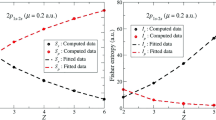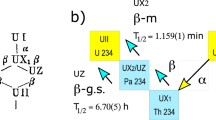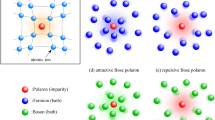Abstract
The existence of a metastable cluster He *4 with total spin S = 2 is predicted. The cluster consists of two covalently bound excited spin-polarized triplet He *2 molecules and is rectangular in shape. The electron wavefunctions, the dependence of the energy He *4 system on the distance between the He *2 triplet molecules, the atomic spacing, the frequency spectrum of natural oscillations of the cluster, and other characteristics are calculated from first principles. It is shown that the metastable state is formed if one of the excited He *2 molecules is in the 3Σ +u state, while the other is in the 3Πg state. The radiation lifetime τ of the metastable cluster He *4 is calculated; it is found to range from 100 to 200 s, which is much longer than the lifetime τ ≈ 20 s of the triplet molecule He *2 (3Σ +u ). The height U ≈ 0.5 eV of the potential barrier preventing the departure from the local energy minimum is determined. The energy E acc ≈ 9 eV/atom accumulated in the He *4 cluster is calculated; this energy considerably exceeds the energy of known chemical energy carriers. It is shown that the accumulated energy is released virtually completely during decomposition of the He *4 cluster into individual helium atoms. This means that helium clusters are a promising material with a high accumulated energy density (HEDM).
Similar content being viewed by others
References
H. W. Kroto, J. R. Heath, S. C. O’Brien, et al., Nature 318, 162 (1985).
T. L. Makarova, B. Sundqvist, R. Hohne, et al., Nature 413, 716 (2001).
A. F. Hebard, M. J. Rosseinsky, R. C. Haddon, et al., Nature 350, 600 (1991).
V. F. Elesin, N. N. Degtyarenko, and L. A. Openov, Inzh. Fiz., No. 3, 2 (2002).
D. N. McKinsey, C. R. Brome, J. S. Butterworth, et al., Phys. Rev. A 59, 200 (1999).
C. F. Chabalowski, J. O. Jensen, D. R. Yarkony, and B. H. Lengsfield III, J. Chem. Phys. 90, 2504 (1989).
A. V. Konovalov and G. V. Shlyapnikov, Zh. Éksp. Teor. Fiz. 100, 521 (1991) [Sov. Phys. JETP 73, 286 (y1991)].
S. Sokolova, A. Lüchow, and J. B. Anderson, Chem. Phys. Lett. 323, 229 (2000).
S. Fujinaga, Method of Molecular Orbitals (Iwanami Shoten, Tokyo, 1980; Mir, Moscow, 1983).
P. Hohenberg and W. Kohn, Phys. Rev. 136, B864 (1964).
W. Kohn and L. J. Sham, Phys. Rev. 140, A1133 (1965).
O. Gunnarsson and B. I. Lundqvist, Phys. Rev. B 13, 4274 (1976).
A. D. Becke, Phys. Rev. A 38, 3098 (1988).
C. Lee, W. Yang, and R. G. Parr, Phys. Rev. B 37, 785 (1988).
M. W. Schmidt, K. K. Baldridge, J. A. Boatz, et al., J. Comput. Chem. 14, 1347 (1993).
G. D. Fletcher, M. W. Schmidt, and M. S. Gordon, Adv. Chem. Phys. 110, 267 (1999).
C. W. H. Drake, Phys. Rev. A 3, 908 (1971).
C. A. Coulson, Valence (Oxford Univ. Press, Oxford, 1961; Mir, Moscow, 1965).
H. Buchenau, J. P. Toennies, and J. A. Northby, J. Chem. Phys. 95, 8134 (1991).
B. von Issendorff, H. Haberland, R. Fröchtenicht, and J. P. Toennies, Chem. Phys. Lett. 233, 23 (1995).
É. A. Manykin, M. I. Ozhovan, and P. P. Poluéktov, Khim. Fiz. 18, 88 (1999).
Author information
Authors and Affiliations
Additional information
__________
Translated from Zhurnal Éksperimental’no\(\overset{\lower0.5em\hbox{$\smash{\scriptscriptstyle\smile}$}}{l} \) i Teoretichesko\(\overset{\lower0.5em\hbox{$\smash{\scriptscriptstyle\smile}$}}{l} \) Fiziki, Vol. 128, No. 1, 2005, pp. 54–66.
Original Russian Text Copyright © 2005 by Elesin, Degtyarenko, Matveev, Podlivaev, Openov.
Rights and permissions
About this article
Cite this article
Elesin, V.F., Degtyarenko, N.N., Matveev, N.V. et al. Metastable helium cluster He *4 . J. Exp. Theor. Phys. 101, 44–55 (2005). https://doi.org/10.1134/1.2010660
Received:
Issue Date:
DOI: https://doi.org/10.1134/1.2010660




